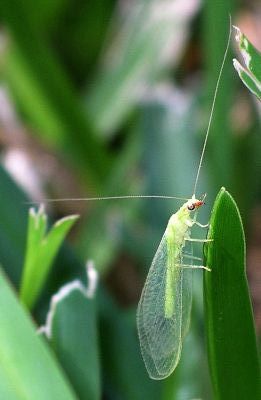by Valerie
February, 2004Green Lacewing
One of our more common flying insects is the green lacewing (Chrysopa sp.). A member of the order Neuroptera and the family Chrysopidae (derived from a Greek word referring to golden appearance), this insect is a type of common lacewing. I've seen at least one other species of green lacewing in our yard (which has black veins in its wings), but this one tends to be most common and is easy to identify by the pale stripe down its back. Although we see the larvae and eggs during much of the summer, it isn't until later in the season that the adults become very numerous. By autumn, the lacewings sometimes appear like a swarm whenever vegetation is disturbed and they are frightened from their camouflaged hiding places. Green lacewings are not always the same color, sometimes being more yellowish or reddish. I've heard various reasons for this, including that the change occurs due to temperature differences during the final metamorphosis from pupa to adult, and that adults change color with the season or temperature. Because there is so little information available, I cannot be sure of the exact cause. Very beneficial insects, the larvae are voracious predators, preferring aphids as their main prey. The adults may sometimes also eat aphids, but are mainly vegetarian. Lacewings have a foul odor (although I've never noticed it) which gives them another name: stinkfly. The larvae are called aphid-lions. While there are many insects whose eggs we never see, those of lacewings are quite distinctive and visible. They are small, white, and placed at the ends of long thin stalks. Lacewings are almost never seen until they fly. Their green color blends in with vegetation, and the clear wings certainly don't stand out. Adults are active at night and often found around outside lights. The best way to see the larvae is to look in an aphid colony. The individual in the photograph was resting in our St. Augustine grass and spent at least 10 minutes carefully grooming and cleaning its long antennae. |
(More information on the order Neuroptera is available in "larvalbug's garden.")